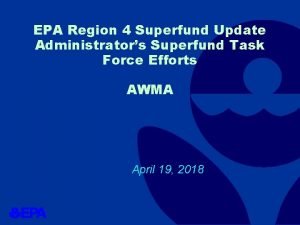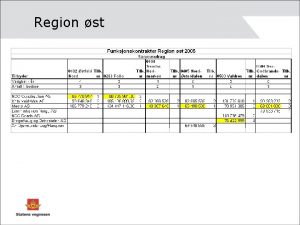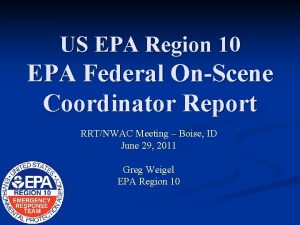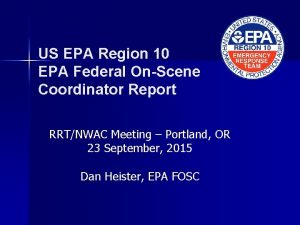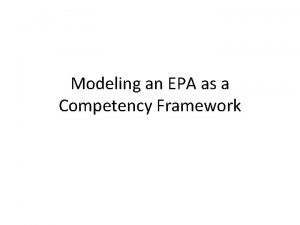Summary of EPA Region 4 Modeling Activities EPA









- Slides: 9

Summary of EPA Region 4 Modeling Activities EPA REGION 4 SPRING GRANTS/PLANNING MEETING May 21 -23, 2019 1

Stan 2. 0 Region 4 Modeling Team Stan 2. 0 (Virtual Stan) Mike Moeller (Half-time modeling, half-time monitoring) Katie Walther Chris Howard Richard Monteith Rick Gillam Katy Lusky (honorary modeler – senior technical advisor) Todd Rinck (Supervisor) 2

FY 2018/2019 Significant Modeling Activities • PSD Permit Applications and Modeling Protocols • SO 2 Attainment Demonstration and Re-designation SIPs • DRR SO 2 On-Going Verification Annual Reports and Transport i. SIPs • Regional Haze Modeling • Held Region 4 State & Local Modeling Workshop in September 2018 • Attended 2019 EPA Regions, States and Locals Modelers Workshop in Seattle, Washington from May 6 -9, 2019 • Thank You for allowing your modeling staff to attend these beneficial workshops! 3

PSD/NSR Permit Modeling ◦ Reviewed and Commented on 16 PSD Permit Applications and 6 PSD Modeling Protocols in FY 2018 ◦ Reviewed 19 PSD Permit Application Modeling Projects so far in FY 2019 ◦ Reviewed 6 PSD Modeling Protocols reviewed so far in FY 2019 ◦ Outlook is for continued high volume of PSD modeling activity Issues and Questions: ◦ Single-source secondary ozone and PM 2. 5 analyses (MERPs Guidance) ◦ Challenging to apply MERPs for Class I area increment SILs assessment ◦ GA, TN and KY developed state-specific MERPs Guidance documents ◦ Modeling “Nearby Sources” with “typical operations” - Revisions to Table 8. 1 and 8. 2 in Appendix W ◦ Additional guidance on “significant concentration gradient” and determination of sources to explicitly model in cumulative modeling analyses is needed 4

Challenges Applying MERPs for Class I Increment Assessments o. Example: 24 -hr PM 2. 5 Class I SIL = 0. 27 ug/m 3 vs. Class II SIL = 1. 2 ug/m 3 o. If conservative “first-cut” MERPs approach is used, then may exceed the Class I SIL in many cases o. Region 4 Modeling Staff have worked with OAQPS to develop a more refined procedure using the results of the photochemical modeling done to establish the MERPs o. Region 4 Modeling Staff are available to assist and provide the data needed to apply this refined methodology 5

SO 2 Attainment Demonstration and Redesignation SIPs ◦ Round 1 Attainment Demonstration SIPs ◦ Jefferson County, Kentucky ◦ Final approval action nearing completion – May 2019 ◦ Sullivan County, Tennessee (Eastman Chemical Company) ◦ Newly deployed monitors showing exceedances of the NAAQS – Eastman evaluating additional controls ◦ Redesignation SIPs ◦ 2 Round 1 Areas in Florida (Hillsborough and Nassau Counties) ◦ Nassau County Redesignation Approved in April 2019 ◦ Hillsborough County Approval under final review ◦ Round 3 Hillsborough-Polk NAA ◦ Controls will be installed by August 2019 – draft Redesignation FR and TSD in development ◦ Plan to finalize in Sept 2019 after permit limits are effective and controls are in place. 6

DRR SO 2 On-Going Verification and Transport i. SIPs ◦ DRR Ongoing Verification ◦ Annual reports due by July 1, 2019, for areas designation A/U in Round 3 Designations ◦ 33 Areas in Region 4 have reports due ◦ Georgia, Kentucky, and Florida have submitted draft reports ◦ EPA Region 4 reviewed submittals and provided comments ◦ Georgia requested termination of reporting requirement for 2 areas ◦ Provided modeling for both areas showing max modeled values below 50% of the NAAQS using recent emissions ◦ Region 4 reviewed modeling and has approved termination for both areas ◦ Approval consists of a letter signed by the RA accompanied by a brief TSD ◦ Florida and South Carolina also interested terminating annual reporting requirement for 1 area in each state ◦ SO 2 Transport i. SIPs ◦ Assisting SIP Regulatory staff when submittals involve modeling ◦ NC performed additional modeling for a Round 4 source located within 50 km of border ◦ TN performed additional modeling for similar sources 7

Regional Haze Modeling ◦ Working with Mississippi to re-evaluate BART Modeling (sources that originally relied on “CAIR/CSAPR better than BART” ◦ 2 nd Round of Regional Haze SIPs ◦ Reviewed and approved VISTAS Modeling QAPP ◦ Reviewed and provided comments on Modeling Protocol (CAMx) ◦ Available to work with VISTAS to review modeling results and assist states as they prepare their Round 2 Regional Haze SIPs 8

Questions? Contact: Rick Gillam Air Data and Analysis Section EPA Region 4 404. 562. 9049 gillam. rick@epa. gov
 Epa region 4 administrator
Epa region 4 administrator Modeling and role modeling theory
Modeling and role modeling theory Relational modeling vs dimensional modeling
Relational modeling vs dimensional modeling The statement of cash flows helps users
The statement of cash flows helps users Indoor and outdoor sports activities
Indoor and outdoor sports activities Primary and support activities
Primary and support activities Definition of primary activities
Definition of primary activities Muscles of the scapular region
Muscles of the scapular region Ece
Ece City and guilds epa price list
City and guilds epa price list
